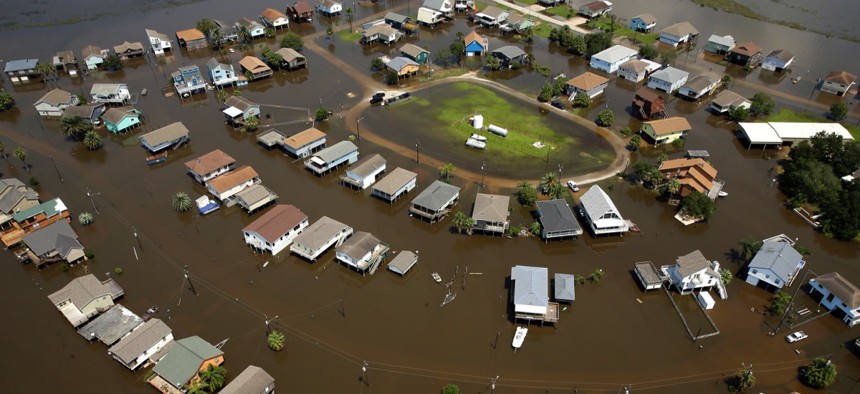'Federally Supported, State Managed, Locally Executed' Disaster Recovery

Homes are surrounded by flood water in the aftermath of Hurricane Harvey near Galveston, Texas. Charlie Riedel / AP Photo
FEMA wants state and local governments to play a 'larger role' post-disaster while shifting those funds to mitigation.
WASHINGTON — The Federal Emergency Management Agency wants to quadruple its investment in disaster mitigation by 2022 using aid money, a plan supported by regional officials in beleaguered states like Texas—so long as the funding formula is amenable.
On Monday, the Trump administration proposed a budget including a record $85 billion for disaster aid, and 2018 stands to see an unprecedented amount of mitigation funding flow to areas impacted by hurricanes Harvey, Irma and Maria.
Awarding money typically doled out post-disaster to communities based on risk “would be a force multiplier in mitigation,” Daniel Kaniewski, FEMA’s deputy administrator for protection and national preparedness, told Route Fifty following a speech at the National Association of Regional Councils’ winter meeting in D.C.
“We believe that mitigation dollars should be available to every community prior to a disaster, but by law most of our mitigation dollars are only available to those communities hit by a disaster,” Kaniewski said. “What about all those communities that haven't been hit by a disaster and have known vulnerabilities?”
Texas Association of Regional Councils Executive Director Ginny Lewis liked the idea in theory but didn’t want to see areas that have never experienced a disaster prioritized in a competitive process to the detriment of those like her own, which was hard hit by Hurricane Harvey and is at higher risk of another. More mitigation money is an improvement, she said, but “the funding formula will be very telling.”
Every $1 spent on mitigation saves $6 in necessary post-disaster aid, according to a National Institute of Building Sciences report released in January.
“Recovery takes too long and it costs too much, said Chuck Wemple, Houston-Galveston Area Council chief operation officer. “So whatever we can do to increase mitigation and diversion is a great investment of funds.”
Coherent multi-year strategies would be required of areas competing for mitigation funds, Kaniewski said, but that would allow localities to prioritize resilience efforts in their own backyards.
A change in the Stafford Act regulating aid is necessary to shift funds to mitigation, but currently 75 percent of all presidentially declared disasters are small—requiring $41 million or less in assistance. FEMA envisions “federally supported, state-managed, locally executed” disaster response, where state and local governments “play a larger role” moving forward, Kaniewski said.
“Texas is a great example of a state that has both the interest and the ability to step up and manage their own recovery program,” he said. “For those states, particularly the smaller ones, that may not have that capability, we are beginning a dialogue with them and finding out what gaps they may have that would prevent them from executing a portion of that vision.”
FEMA soon plans to announce a pilot program in a handful of states supporting gaps in their recovery, Kaniewski said.
In the meantime, the agency has begun outreach to state and local governments, which includes appearances at meetings like NARC’s.
“I think it’s reassuring to hear an emphasis on local program implementation and allowing states to have more input and control in how the programs are run,” Lewis said
Where the money for mitigation will come from in the budget is another story.
“The budget is what it is,” Kaniewski said. “[FEMA Administrator] Brock Long supports the president’s budget but also acknowledges that, going forward, we need to take the post-disaster money and move it pre-disaster.”
Dave Nyczepir is a News Editor at Government Executive’s Route Fifty and is based in Washington, D.C.
NEXT STORY: Why Police Backing Is Key to Needle Exchanges






